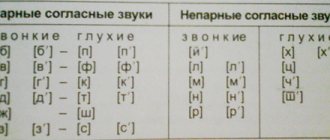Ontogenesis of phonemic processes article on speech therapy on the topic
Ontogenesis of phonemic processes
Human phonemic processes (phonemic system) consist of phonemic hearing and phonemic awareness, with the latter including simple and complex forms of phonemic analysis, phonemic synthesis, and phonemic representations.
The functions of the phonemic system were defined and disclosed by V.K. Orfinskaya:
- semantic-distinguishing function (a change in one phoneme or one semantic-distinguishing feature leads to a change in meaning);
- auditory-pronunciation differentiation of phonemes (phonemic perception: each phoneme differs from every other phoneme acoustically and articulatory);
- phonemic analysis, i.e., decomposition of a word into its constituent phonemes (8).
The phonemic aspect of speech is provided by the work of a speech-hearing analyzer. Its peripheral section is located in the organ of Corti and receives auditory information, including speech sounds.
The conduction section transmits information to the cerebral cortex, partially analyzing it, determining the direction and distance of the sound source. This function is provided by a large number of transmission links (8 pair of cranial nerves, medulla oblongata, cerebellum, midbrain, medial geniculate body and auditory radius).
The central section of the speech-hearing analyzer is the temporal section of the speech-dominant hemisphere (for right-handers - the left) - the Wernicke center, where the analysis of sounding speech is carried out: the presence of sound in a word, the features of its positional sound, the number and order of sounds in a word, the distinction of similar acoustic parameters are controlled sounds.
In ontogenesis, the development and formation of phonemic processes occurs gradually.
Phonemic hearing is the sensory basis of our speech. Unlike sound-pitch or musical hearing, aimed at distinguishing sounds of different pitches, phonemic hearing is “engaged” in distinguishing phonemes - parts of a word that have “sense”, content, and meaning.
In some eastern languages, the same sounds pronounced at different pitches denote different objects. In the Russian language, phonemes are constant and do not depend on timbre and pitch (9).
Phonemic hearing is a subtle, systematized hearing that allows you to distinguish and recognize phonemes of your native language (1). Phonemic hearing, being part of physiological hearing, is aimed at correlating and comparing audible sounds with their standards, which are stored in a person’s memory in the “phoneme lattice” (7).
Phonemic hearing begins to develop in a child very early. Already at 3-4 weeks of life, the child distinguishes human speech from any other sound stimuli. It has been repeatedly noted that the child gradually becomes more and more “attentive” to the sounds of human speech. From birth, the baby's hearing is not adapted to the subtle discrimination of speech sounds. In perceiving the speech of an adult, a child goes through several stages: first, he reacts to the intonation of speech addressed to him, then rhythm acquires special significance for him, and only after that, already at the end of the first year of life, the child begins to distinguish words by their sound composition . A child's hearing quickly adapts to the sounds of his native language.
Research by domestic psychologists and linguists - N. X. Shvachkina and A.N. Gvozdev showed that by the age of two, a child can distinguish all the sounds of his native language. In other words, by the age of two, a child’s phonemic hearing is formed. (5).
By the age of 4, a child should normally differentiate all sounds, i.e. he must have developed phonemic perception - this is the ability to distinguish phonemes and determine the sound composition of a word. By this time, the child has completed the formation of correct sound pronunciation.
By the age of five, children's phonemic processes improve: they recognize sounds in a stream of speech and can choose a word for a given sound.
By the age of six, children are able to correctly pronounce all the sounds of their native language and words of various syllable structures. A well-developed phonemic ear allows a child to identify syllables or words with a given sound from a group of other words and differentiate phonemes that are similar in sound. At the age of 6 years, children speak, in general, correctly, but still a significant number of them have phonetic speech defects (distortions, more often substitutions of sounds) (5).
Phonemic perception is the mental activity of isolating and distinguishing phonemes, of determining the sound composition of a word (1). Phonemic perception of speech sounds occurs during the interaction of auditory and kinesthetic stimuli entering the cortex. Gradually, these stimuli are differentiated, and it becomes possible to isolate individual phonemes. In this case, primary forms of analytical-synthetic activity play an important role, thanks to which the child generalizes the characteristics of some phonemes and distinguishes them from others. Through analytical-synthetic activity, the child compares his imperfect speech with the speech of his elders and forms sound pronunciation. Lack of analysis or synthesis affects the development of pronunciation as a whole. However, if the presence of primary phonemic hearing is sufficient for everyday communication, then it is not enough for mastering reading and writing. A. N. Gvozdev, V. I. Beltyukov, N. Kh. Shvachkin, G. M. Lyamina proved that it is necessary to develop higher forms of phonemic hearing, in which children could divide words into their constituent sounds, establish the order of sounds in word, i.e. analyze the sound structure of a word.
D. B. Elkonin called these special actions to analyze the sound structure of words phonemic perception. In connection with literacy learning, these actions are formed through the process of special education, in which children are taught the means of sound analysis. (6).
Phonemic analysis is the operation of mental separation into component elements (phonemes) of different sound complexes: combinations of sounds, syllables and words.
Phonemic analysis can be basic or complex. Elementary phonemic analysis is the isolation (recognition) of a sound against the background of a word (from four to five years old), the isolation of the initial stressed vowel from a word (from the age of five); it appears spontaneously in preschool children. A more complex form is to isolate the first and last sound from a word, determining its place (beginning, middle, end of the word). And finally, the most complex form of phonemic analysis is determining the sequence of sounds in a word (sequential analysis), their quantity (quantitative analysis), and their place in relation to other sounds (after which sound/before which sound - positional analysis). Children master such phonemic analysis only in the process of special education (from the age of six) (3).
D.B. Elkonin gives the following definition of phonemic analysis:
- determining the order of syllables and sounds in a word,
- establishing the distinctive role of sound,
- highlighting the qualitative main characteristics of sound (2).
Phonemic synthesis is the mental process of combining sounds into a whole word (from 6 years old). In other words, phonemic synthesis is a process opposite to analysis, but they are closely interrelated and inseparable from each other.
Phonemic representations – the ability to carry out phonemic analysis of words in the mental plane, based on auditory-pronunciation representations.
Phonemic representations are formed in children as a result of observations of various variants of phonemes, their comparison and generalization. This is how constant phonemic representations are formed - the ability to perceive each speech sound in various variants of its sound as identical to itself. A child’s phonemic understanding of the sound composition of a language is formed on the basis of the acquired ability to hear and distinguish sounds (phonemic hearing), identify sounds against the background of a word, and compare words by identified sounds (phonemic analysis). There are several periods in the formation of phonemic representations. At the first stages (from one to three years), phonemic representations develop in accordance with their own incorrect pronunciation. In the process of further development, the child masters the ability to not always take into account the articulation of sounds, i.e. the speech-auditory analyzer is freed from the inhibitory influence of speech-motor analysis. (8).
List of used literature
- Arkhipova, E.F. Erased dysarthria in children / E.F. Arkhipova. - M.: AST: Astrel, 2007.
- Gvozdev A.N. Questions of studying children's speech / A.N. Gvozdev – M.: Detstvo-Press, 1961.
- Lalaeva R.I. Speech therapy work in correctional classes. – M., 2004.
- Speech therapy: Textbook for students of defectology. fak. ped. universities / Ed. L.S. Volkova, S.N. Shakhovskaya. — M.: Humanite. ed. VLADOS center, 1998.
- Lopatina, L.V., Serebryakova N.V. Overcoming speech disorders in preschool children (correction of erased dysarthria): a textbook. / L.V. Lopatina, N.V. Serebryakova - St. Petersburg: Publishing house "SOYUZ", 2000.
- Basics of speech therapy with a workshop on sound pronunciation: Textbook. aid for students avg. ped. schools, institutions / Fomicheva M.F., Volosovets T.V., Kutepova E.N., etc.; Ed. T.V. Volosovets. - M.: Publishing House, 2002.
- Fundamentals of speech therapy work with children: A textbook for speech therapists, kindergarten teachers, primary school teachers, students of pedagogical schools. / Under the general ed. Doctor of Science, Prof. G. V. Chirkina. – 2nd ed., rev. – M.: ARKTI.
- Sadovnikova, I.N. Formation of phonemic analysis/ I.N. Sadovnikova // Correctional education for schoolchildren with reading and writing disorders. A manual for speech therapists, teachers, psychologists of preschool institutions and schools of various types. - M.: ARKTI, 2005.
- Shashkina, G.R. and others. Speech therapy work with preschoolers: Textbook. allowance for students higher ped. textbook institutions / G. R. Shashkina, L. P. Zernova, I. A. Zimina. - M.: Publishing House, 2003.
Contents of correctional education for children with phonetic-phonemic underdevelopment
The main objectives of correctional education are the following:
!. Formation of sound pronunciation.
2. Development of phonemic hearing.
3. Preparing for literacy.
Speech therapy work begins with clarifying the articulation of the children’s (preserved) sounds.
Organizational classes are conducted both frontally (with the whole group) and individually.
Frontal classes are conducted throughout the year in a specific system according to a single plan, taking into account the individual characteristics of children. In these classes, first of all, the pronunciation of vowel sounds is practiced: u, a, i, e, o,
then simple consonants:
p, p', k, k', l', x, s, s', z, z'
and newly delivered sounds:
c, t, b, b', d, d', g, g ', w, l, f, r, r', h, sch.
In the process of developing sound pronunciation, children develop attention to the sound side of speech. By correcting the pronunciation of sounds, the speech therapist teaches children to listen attentively to speech, to distinguish and reproduce individual elements of speech, to retain in memory the material perceived by ear, to hear the sound of their own speech and to correct their mistakes. Along with exercises to consolidate the given sounds, exercises are gradually introduced to differentiate sounds according to the following characteristics: unvoiced and voiced (f-v, s-z, p-b, t-d, k-g, sh-zh)
;
whistling and hissing (s-sh, z-zh)',
fricatives and affricates
(s-ts):
smooth and vibrant
(r-l, r'-l'),
soft and hard
(s-s', z-z '
and etc.).
In order to develop attention to the sound side of speech and auditory memory, the training system provides special exercises that can be divided into two groups. One group of exercises is aimed only at speech perception - children answer questions using actions and showing pictures. This includes memorizing a series of words perceived by ear, specially selected instructions and other speech material. These exercises are especially necessary at the very beginning of learning, when children's active, correctly pronounced vocabulary is limited. The second group of exercises, having the same goals, provides not only for the correct perception of lexical material, but also for its reproduction. This includes repetition of syllabic series, series of words, sentences perceived by ear; learning by heart various speech material in connection with the consolidation of correct sound pronunciation.
As children master new sounds, they are gradually introduced to changing word forms depending on gender, number, case, and time of action. So, for example, when fixing the correct pronunciation of the sounds s, s', з, з'
children match nouns to adjectives
(blue... bus, blue... vase, green... bench).







